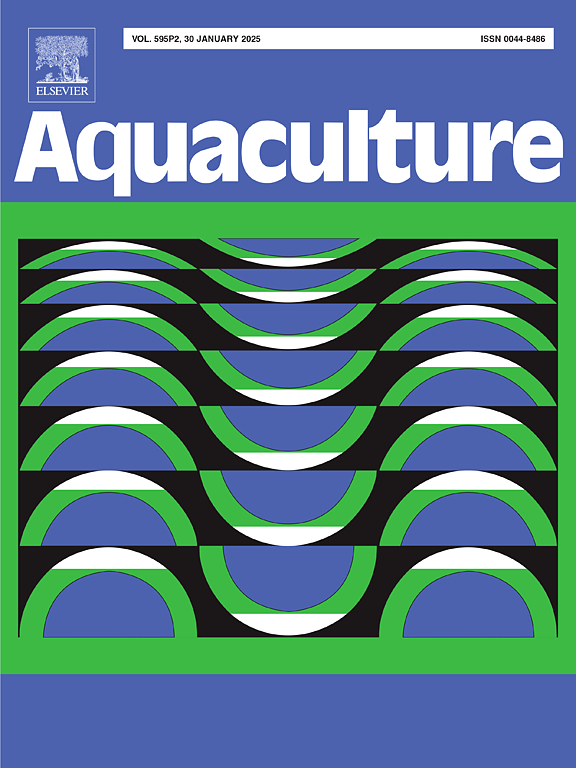Impact of commercial probiotics (Bacillus subtilis) addition during biofloc start-up: water quality, nitrogen conversion, nutrition and microbial community
IF 3.9
1区 农林科学
Q1 FISHERIES
引用次数: 0
Abstract
Although probiotics are used widely in aquaculture, the role of probiotics in biofloc construction is still unclear. This study evaluated the impact of commercial Bacillus subtilis addition during biofloc start-up on water quality, nitrogen conversion, nutritional composition, and microbial community. Four treatments were tested: control (Ctr, without B. subtilis and glucose addition), glucose addition (Glu), B. subtilis addition (Bac), and B. subtilis, glucose co-addition (G + B). Results showed no significant difference in the construction time among the four groups, whereas a significant difference was detected in total ammonia nitrogen removal rates between the Ctr and Glu groups (p < 0.05). Glucose-added groups (Glu and G + B) showed significantly higher crude protein, essential amino acids, and total amino acids than non-glucose groups (Ctr and Bac) (p < 0.05). Polyunsaturated fatty acids in Bac (19.53 ± 0.88 %) and G + B groups (22.78 ± 0.84 %) were significantly higher than Ctr group (p < 0.05). Bac group displayed the highest microbial abundance, and the relative abundance of Bacillus genus was significantly higher in Glu and G + B groups than Ctr and Bac groups (p < 0.05). These results indicate that the addition of commercial B. subtilis with glucose enhances biofloc nutrition and has a synergistic effect in optimizing biofloc composition and functionality, suggesting that it should be recommended in the production. This study provides theoretical support for the productional culturing of biofloc and contributes to the understanding of the role of probiotics in biofloc.
生物絮团启动过程中添加商业益生菌(枯草芽孢杆菌)的影响:水质、氮转化、营养和微生物群落
虽然益生菌在水产养殖中应用广泛,但益生菌在生物絮团构建中的作用尚不清楚。本研究评估了在生物絮团启动过程中添加商业枯草芽孢杆菌对水质、氮转化、营养成分和微生物群落的影响。四种处理:对照(Ctr,不添加枯草芽孢杆菌和葡萄糖)、葡萄糖添加(Glu)、枯草芽孢杆菌添加(Bac)和枯草芽孢杆菌、葡萄糖共添加(G + B)。结果显示,四组之间的构建时间无显著差异,而Ctr组和Glu组之间的总氨氮去除率有显著差异(p <;0.05)。葡萄糖添加组(Glu和G + B)的粗蛋白质、必需氨基酸和总氨基酸含量显著高于非葡萄糖添加组(Ctr和Bac) (p <;0.05)。Bac组多不饱和脂肪酸(19.53±0.88%)和G + B组多不饱和脂肪酸(22.78±0.84%)显著高于Ctr组(p <;0.05)。Bac组微生物丰度最高,Glu和G + B组芽孢杆菌属相对丰度显著高于Ctr和Bac组(p <;0.05)。综上所述,商业枯草芽孢杆菌与葡萄糖的添加可提高生物絮团的营养,并在优化生物絮团组成和功能方面具有协同效应,值得在生产中推广。本研究为生物絮团的生产培养提供了理论支持,有助于了解益生菌在生物絮团中的作用。
本文章由计算机程序翻译,如有差异,请以英文原文为准。
求助全文
约1分钟内获得全文
求助全文
来源期刊

Aquaculture
农林科学-海洋与淡水生物学
CiteScore
8.60
自引率
17.80%
发文量
1246
审稿时长
56 days
期刊介绍:
Aquaculture is an international journal for the exploration, improvement and management of all freshwater and marine food resources. It publishes novel and innovative research of world-wide interest on farming of aquatic organisms, which includes finfish, mollusks, crustaceans and aquatic plants for human consumption. Research on ornamentals is not a focus of the Journal. Aquaculture only publishes papers with a clear relevance to improving aquaculture practices or a potential application.
 求助内容:
求助内容: 应助结果提醒方式:
应助结果提醒方式:


